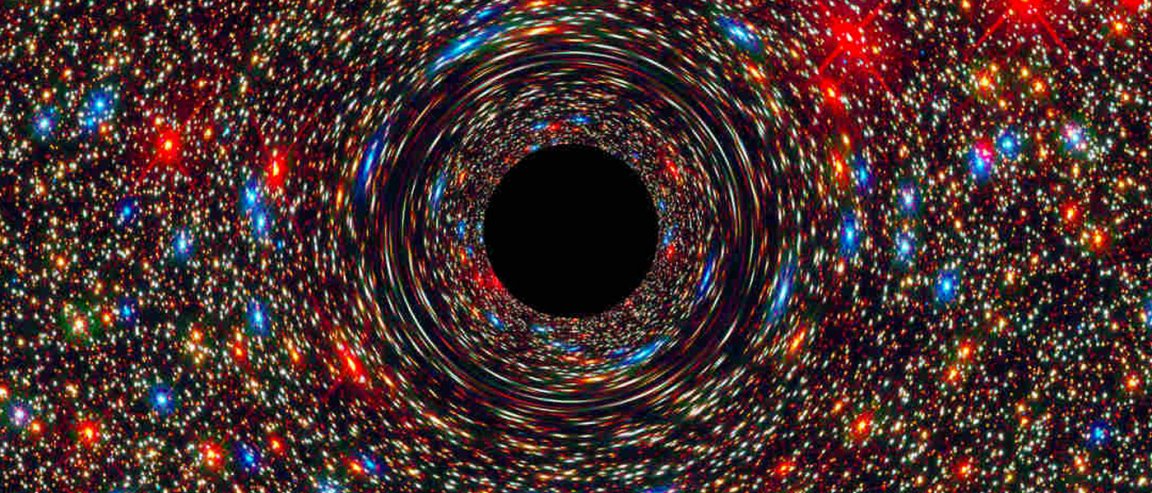
It’s never a good day when you find yourself naked and alone, streaking through an unfamiliar neighborhood. But that’s the reality for a black hole called B3 1715+425, located in a galaxy cluster 2 billion light-years away.
B3 1715+425 started out like any other supermassive black hole, with a full elliptical galaxy full of stars around it. But astronomers have shown that it’s since been stripped and left nearly naked, hurtling through the Universe at 2,000 kilometers a second – with no signs of slowing down.
“We’ve not seen anything like this before,” said lead researcher James Condon, from the National Radio Astronomy Observatory, who thinks the unusual black hole could help us to better understand galaxies form and evolve.
Supermassive black holes – which are millions or billions of times more massive than our Sun – are common throughout the Universe, and lie in the center of most galaxies.
The team spotted this naked rogue while looking for supermassive black holes that weren’t at the centers of galaxies, to try to understand more about these humungous structures. But they weren’t expecting to see B3 1715+425.
“We were looking for orbiting pairs of supermassive black holes, with one offset from the center of a galaxy, as telltale evidence of a previous galaxy merger,”said Condon.
“Instead, we found this black hole fleeing from the larger galaxy and leaving a trail of debris behind it.”
To put its nakedness into perspective, our own Milky Way galaxy is around100,000 light-years across, but the galactic remains left around B3 1715+425 are only 3,000 light-years across.
So what happened to its surrounding galaxy?
The researchers think that the trouble started when it bumped into another galaxy. That’s not unusual, and most large galaxies in the Universe got that way by merging with other, smaller galaxies.
Normally when a bump happens, the supermassive black holes at the centers of each galaxy being to orbit one another, gradually moving closer and closer together until they merge, releasing a huge burst of energy (the first gravitational waves we detected earlier this year came from one of these black hole mergers).
But in the case of B3 1715+425, something went wrong.
Using the Very Long Baseline Array (VLBA) network of telescopes, Condon and his team were able to get a closer look at B3 1715+425.
Based on how the black hole is behaving now, they think is that, millions of years ago, B3 1715+425’s galaxy passed through a much larger galaxy – one that had already swallowed up other galaxies in its path.
Because it was so big, instead of merging into it, B3 1715+425’s galaxy was shredded and ripped apart, with parts of its stellar debris strewn throughout the galaxy cluster.
The supermassive black hole at the center managed to escape with the stars that were closest to it, and that’s what’s left burning through the surrounding space, gradually losing ionising gas as its last remaining stars burn out.
The astronomers believe that, eventually, in about a billion years, B3 1715+425 will become invisible, as it’ll have no new stars left to feed it – but it will likely continue hurtling throughout the Universe without a trace.
That suggests that there might also be more of these naked black holes out there that researchers simply haven’t been able to see before.
Condon and his team will now continue to hunt down more black holes like B3 1715+425, and as better optical telescopes come online, they might have a chance of spotting even very faint naked black holes streaking through the sky.
They might also be able to find some examples of what they were originally looking for: black holes not at the centers of their galaxies.
In the meantime, they’ll continue to study B3 1715+425 to see what it can teach us about how galaxies and galaxy clusters form and evolve.
The research will be published in Astrophysical Journal, and is available in full online now at arXiv.org.
You can see Cordon talking about the incredible discovery below: